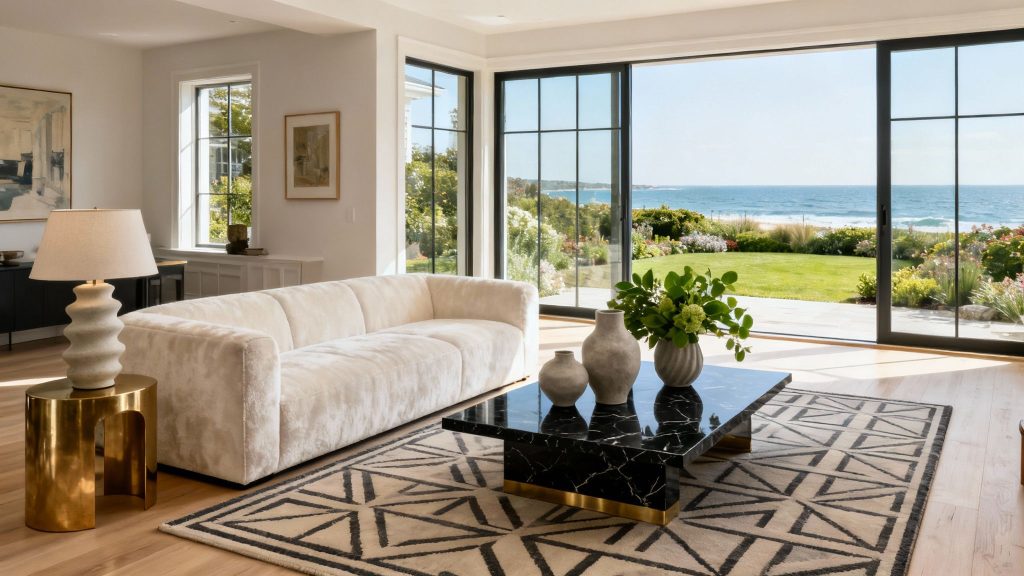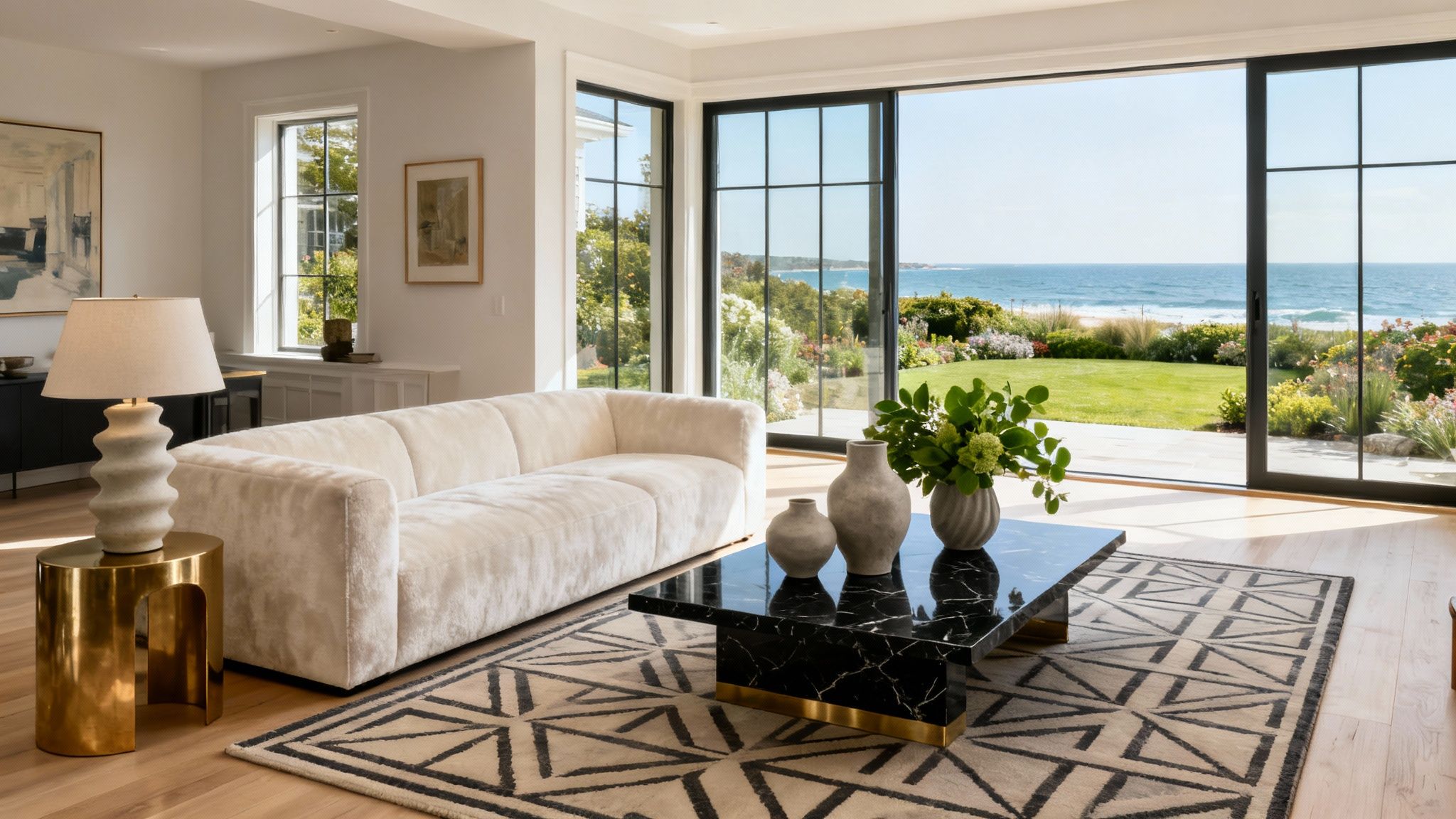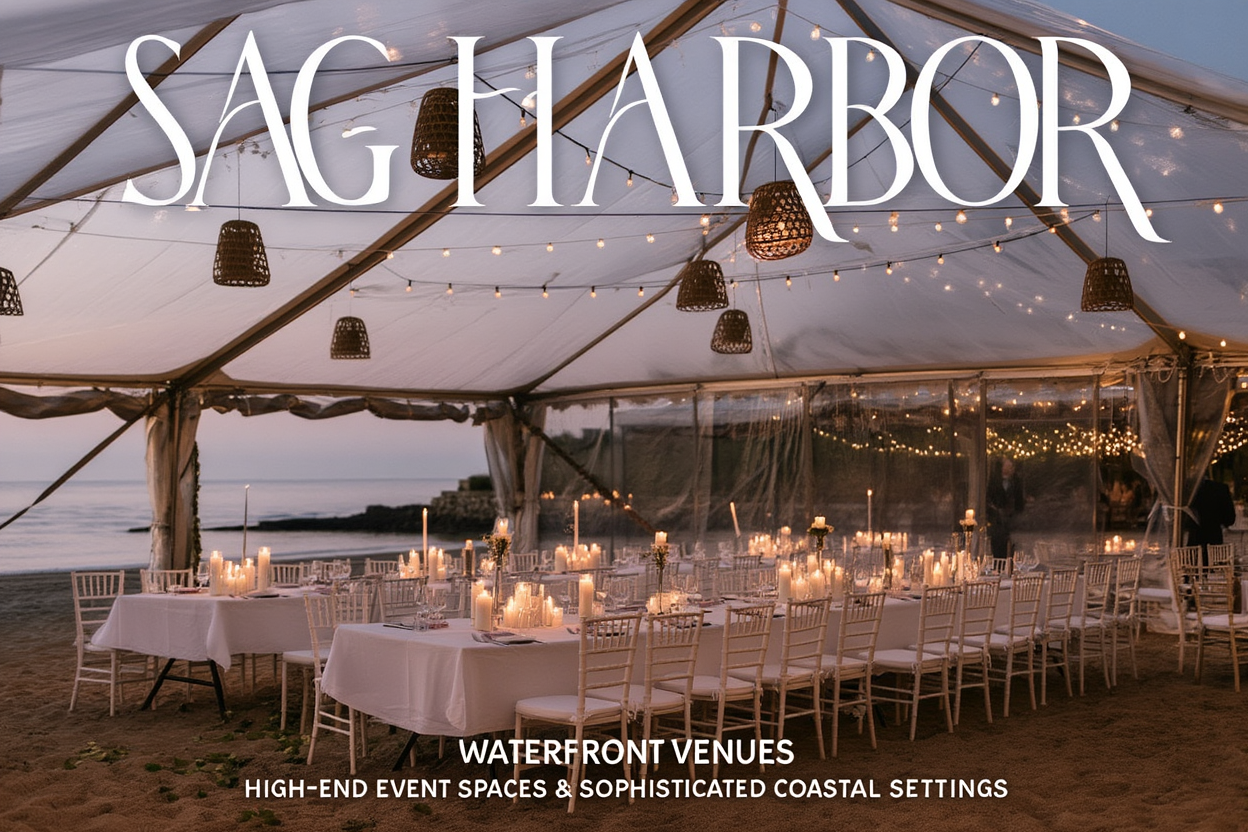True luxury is not merely about expense but about the thoughtful curation of space, texture, and light. For discerning homeowners, creating an environment that is both visually stunning and deeply personal is the ultimate objective. This guide moves beyond fleeting trends to present ten foundational luxury home decor ideas that promise enduring style and sophistication.
Each concept is designed to transform a residence into a sanctuary of refined living. We will explore how to integrate statement pieces, master the art of material selection, and harness technology to create interiors that are as functional as they are beautiful.
Throughout this curated collection, you will find actionable insights for achieving a bespoke aesthetic, from selecting the perfect marble slab to implementing a layered lighting scheme. This article provides a direct, practical roadmap to elevating your space. We will delve into specific strategies for integrating everything from oversized art installations and custom built-ins to textural wall treatments and seamlessly integrated smart home technology, ensuring every detail contributes to a cohesive and elegant whole. Let us explore the elements that define sophisticated living.
1. Statement Lighting Fixtures
Statement lighting elevates a room from merely functional to a curated work of art. This luxury home decor idea involves selecting oversized, sculptural, or artistically significant light fixtures that act as a central design element. More than just a source of illumination, these pieces serve as powerful focal points, defining the character and ambiance of a space. Designers like Kelly Wearstler and Apparatus Studio have mastered this concept, using custom lighting to inject drama and personality into high-end interiors.
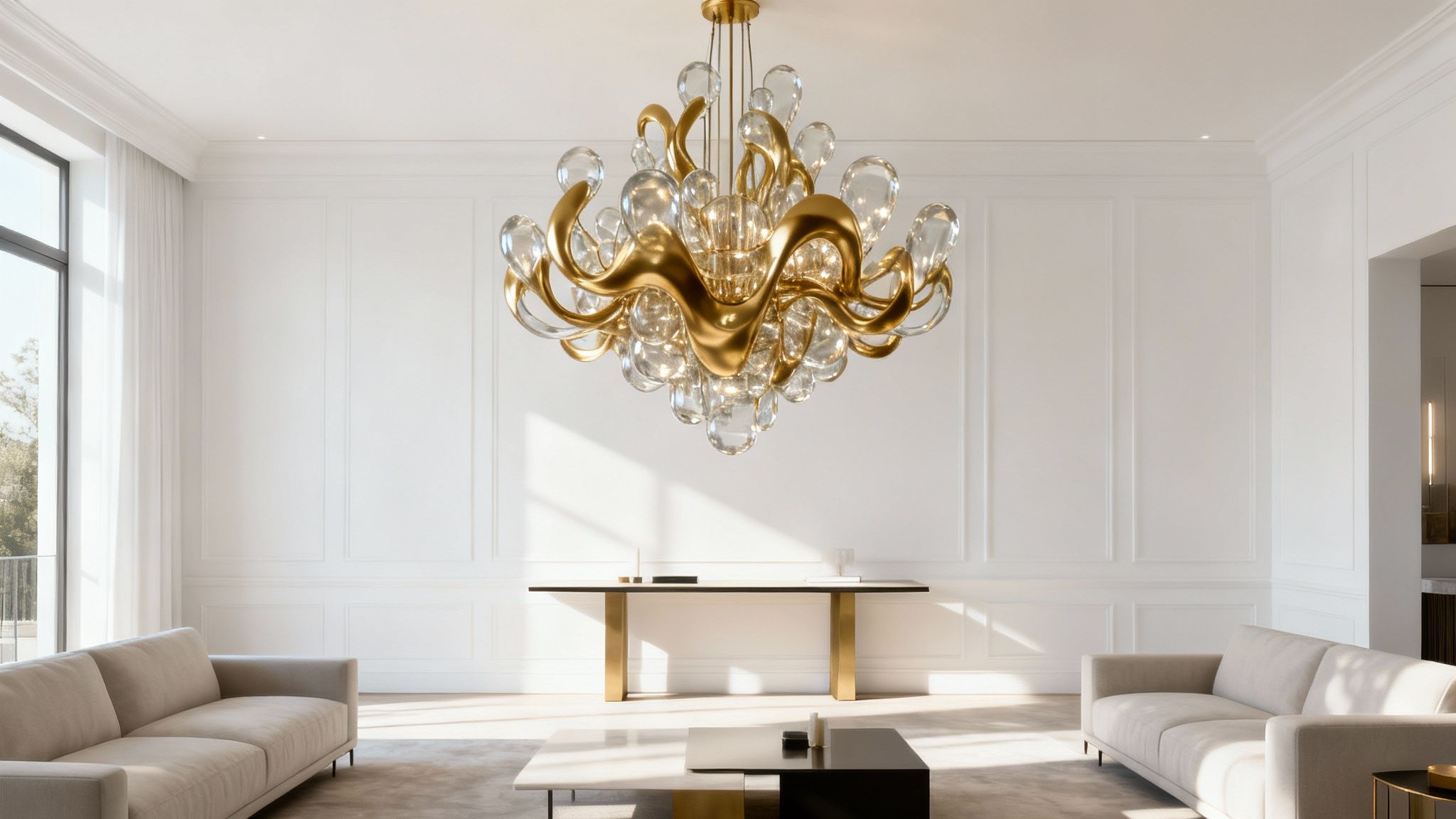
Why It Works
A bold fixture can anchor a room’s entire design scheme, much like a significant piece of furniture or art. In a grand foyer, a cascading Baccarat crystal chandelier creates an immediate impression of opulence. For a modern dining room, a series of Tom Dixon pendant lights can add sculptural interest and a warm, inviting glow, transforming a simple meal into a sophisticated dining experience.
How to Implement Statement Lighting
To successfully integrate this concept, precision is key. Follow these professional guidelines to ensure your fixture enhances, rather than overwhelms, your space:
- Scale and Proportion: In a dining room, the fixture should be one-half to two-thirds the width of the table. For living rooms or foyers, the scale should complement the ceiling height and overall room volume; grand fixtures demand ceilings of at least nine feet.
- Proper Height: Hang chandeliers 30-36 inches above a dining table to maintain sightlines while creating an intimate atmosphere.
- Layered Lighting: A statement piece should not be the sole light source. Complement it with recessed lights, lamps, or sconces to create a balanced and functional lighting plan.
- Control the Mood: Always install dimmer switches. This allows for adjustment of the intensity, transitioning from bright, functional light to a soft, ambient glow effortlessly.
2. Marble and Natural Stone Surfaces
Incorporating marble and other natural stones like onyx, granite, and travertine creates an unmistakable sense of luxury and permanence. This luxury home decor idea hinges on using materials that have been associated with wealth and refinement for millennia. Their unique veining and color variations ensure that each installation, from a kitchen countertop to a bathroom wall, is a one-of-a-kind work of natural art. Designers like Martyn Lawrence Bullard frequently use exotic stones to anchor their high-end, sophisticated designs.
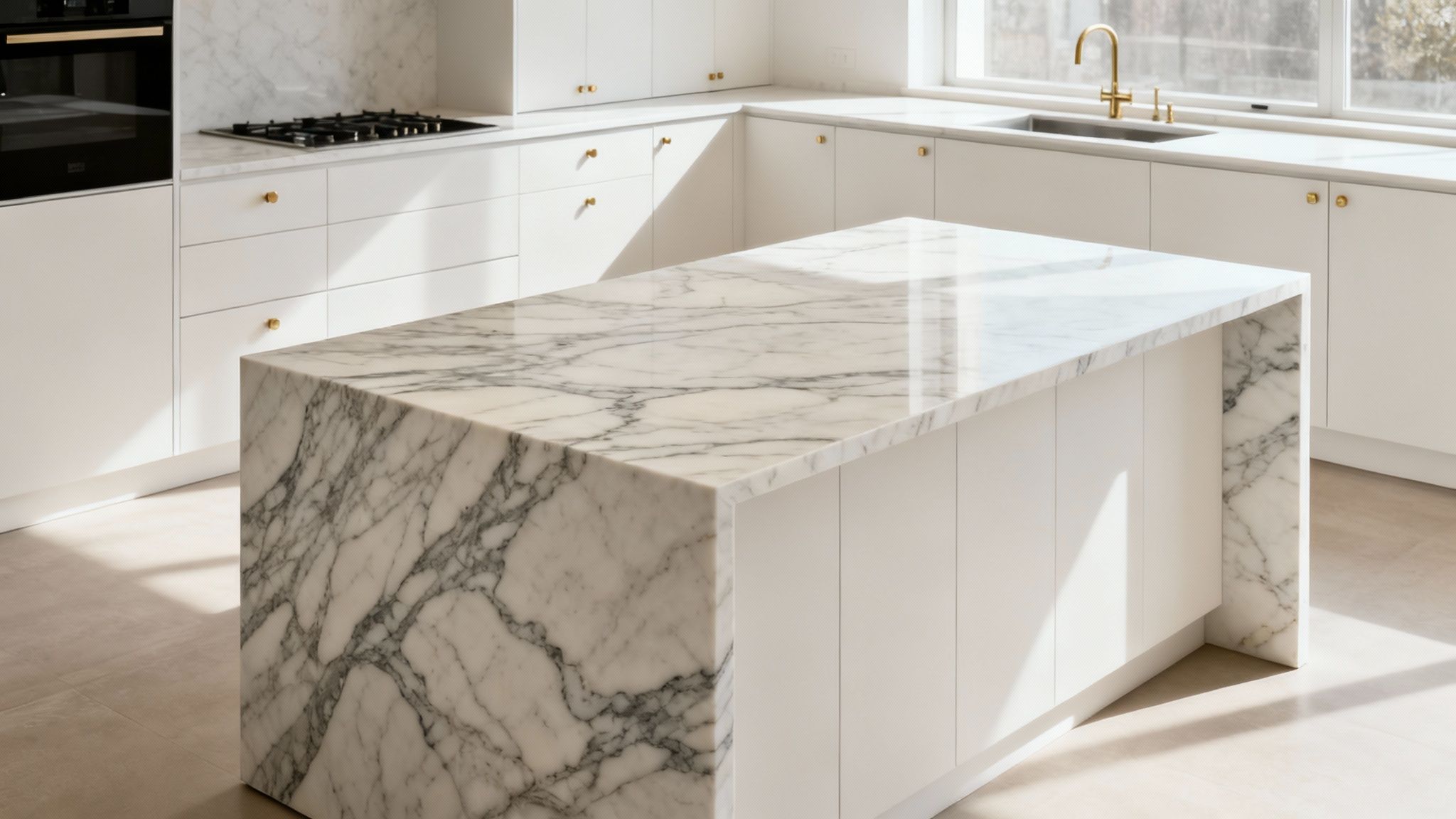
Why It Works
Natural stone imparts a timeless, organic elegance that manufactured materials cannot replicate. In a modern penthouse, a book-matched Calacatta Gold marble feature wall in the master bathroom becomes a dramatic, artistic focal point. For a formal living room, a carved marble fireplace surround provides a sense of grandeur and history, elevating the entire space. These materials do not just decorate; they define the architectural integrity of a home.
How to Implement Natural Stone Surfaces
Proper selection and care are crucial for leveraging the beauty of natural stone. Follow these professional guidelines to ensure a flawless and lasting installation:
- Select Your Slab: Always visit a stone yard to hand-select the specific slab. This allows you to see the true color, veining, and any unique characteristics firsthand, ensuring it aligns with your vision.
- Strategic Placement: Use high-impact stones like onyx for backlit bar fronts or vanities to create a show-stopping effect. For high-traffic areas like entryways, consider a honed finish, which is less likely to show etching than a polished surface.
- Book-Matching: For large, uninterrupted surfaces like a shower wall or kitchen island, ask your fabricator about book-matching two adjoining slabs. This technique creates a stunning, symmetrical mirror image that highlights the stone's natural pattern.
- Protect Your Investment: Natural stone requires maintenance. To ensure these surfaces retain their high-end appeal over time, it is essential to understand proper care, including how to restore marble floors when needed. Always use pH-neutral cleaners and seal porous stones like marble every 6-12 months.
3. Custom Built-In Shelving and Cabinetry
Custom built-ins are the hallmark of a thoughtfully designed home, offering tailored storage and display solutions that merge seamlessly with a room's architecture. Unlike standalone furniture, these bespoke pieces are crafted by skilled artisans to fit the exact dimensions of a space, maximizing both function and form. From premium woods and lacquered finishes to integrated lighting and hidden compartments, custom work transforms entire walls into functional art, a key element in sophisticated luxury home decor ideas.
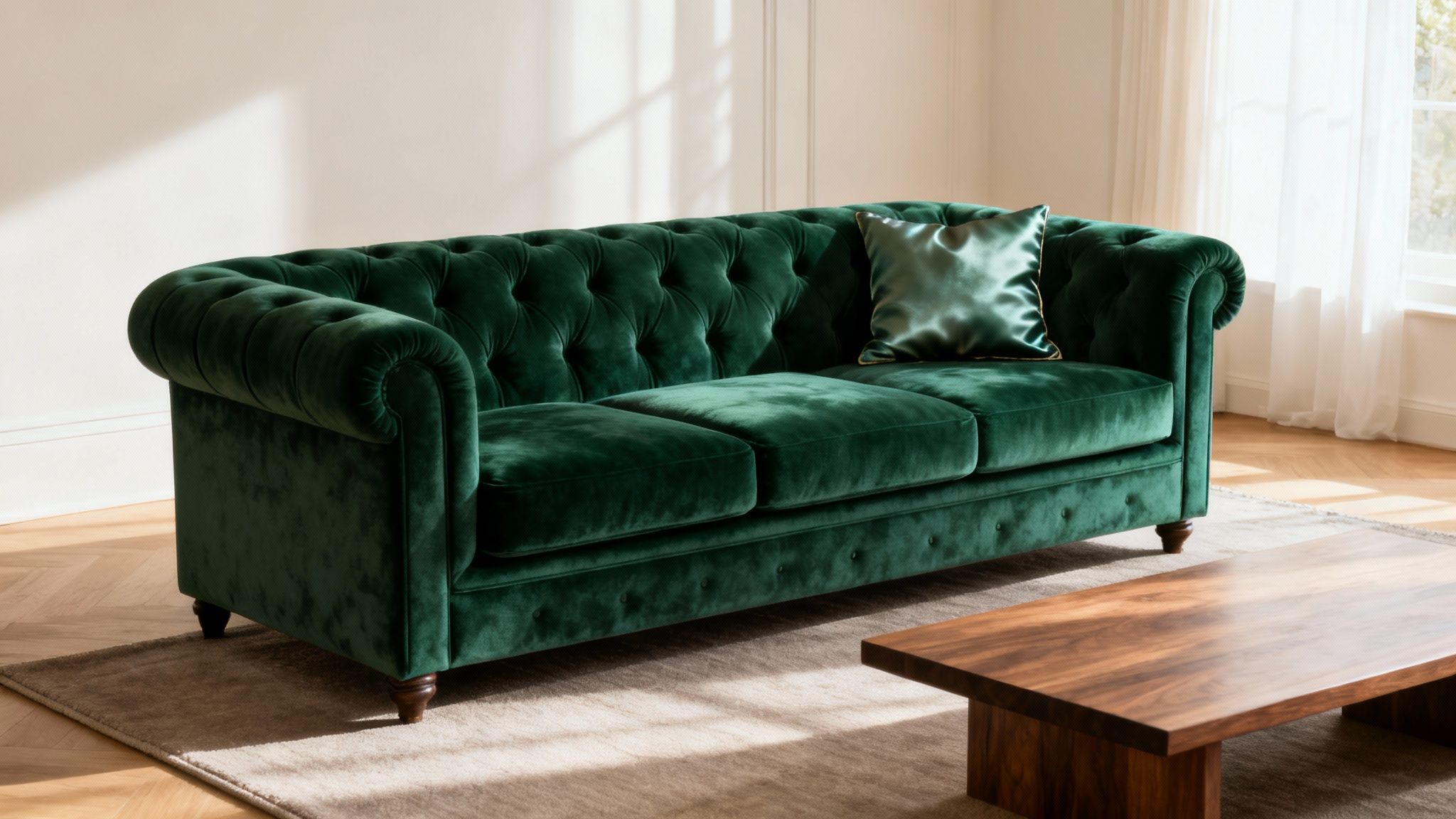
Why It Works
Bespoke cabinetry provides a level of cohesion and intentionality that freestanding furniture cannot match. In a library, floor-to-ceiling walnut shelving with a classic rolling ladder creates an atmosphere of timeless intellect. Meanwhile, a sleek, minimalist entertainment center in a media room can conceal technology with a hidden TV lift, maintaining a clean aesthetic. These solutions are not just storage; they are integral architectural features that elevate the home's value and livability.
How to Implement Custom Built-Ins
Achieving a high-end result requires meticulous planning and collaboration with skilled professionals. Follow these guidelines for a flawless execution:
- Engage Experts: Work with an experienced carpenter or a specialized firm to translate your vision into a detailed architectural plan.
- Material Selection: Choose timeless, high-quality materials such as solid hardwoods or premium veneers that complement your home's existing finishes.
- Integrate Lighting: Incorporate integrated LED strip lighting within shelves to highlight decor and add a layer of ambient warmth.
- Balance Form and Function: Plan for a mix of open shelving for display and closed cabinetry for concealed storage. Ensure practical details like soft-close hinges and planned wire management for electronics are included.
4. Velvet and Luxury Fabric Upholstery
Upholstering furniture in velvet and other luxury fabrics like mohair or high-end linen introduces tactile richness and visual depth, instantly elevating a space. This luxury home decor idea leverages the power of texture to add sophistication and warmth. Velvet, with its light-reflecting pile and historic association with royalty, has become a hallmark of modern opulent interiors. Designers like Abigail Ahern and luxury fabric houses such as Pierre Frey champion these materials to transform functional furniture into coveted statement pieces.
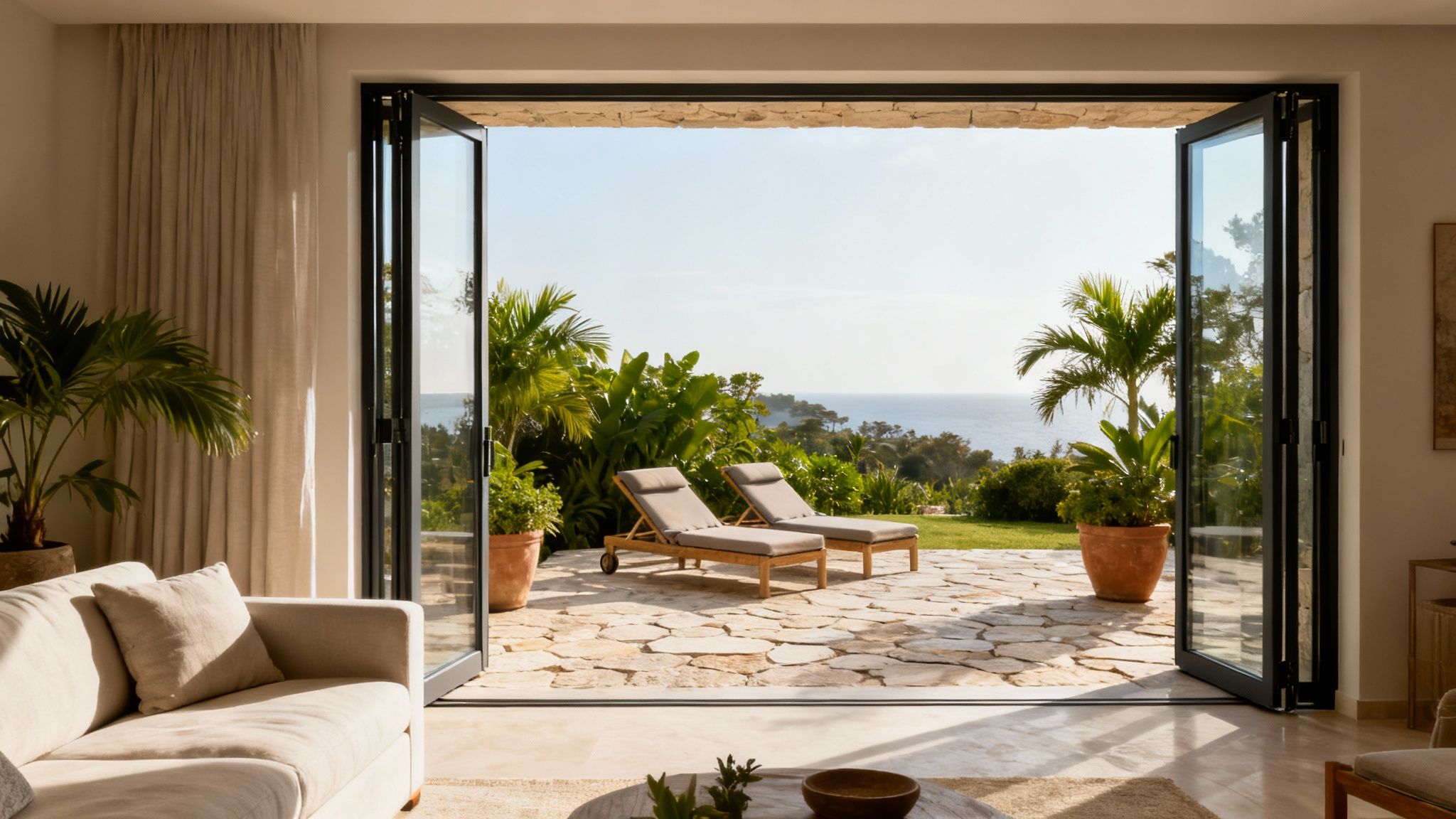
Why It Works
Luxury fabrics add a layer of sensory experience that painted walls or hard surfaces cannot. In a penthouse, an emerald green velvet Chesterfield sofa becomes the anchor of a sophisticated study, its rich color and texture commanding attention. For a chic dining room, blush pink velvet chairs surrounding a marble table introduce a soft, glamorous contrast to the stone's cool elegance. The material itself communicates quality and comfort.
How to Implement Luxury Fabrics
Integrating sumptuous textiles requires a balanced approach to achieve a refined, not overwhelming, look. Follow these professional guidelines for a successful application:
- Choose Performance Fabrics: For high-traffic areas or homes with families, select performance velvets from brands like Crypton or Sunbrella. These offer stain resistance and durability without sacrificing a luxurious feel.
- Create Textural Balance: Mix velvet with other materials to create visual interest. Pair a velvet sofa with linen pillows, a leather armchair, or a polished wood side table to avoid a monolithic look.
- Strategic Color Choices: Use deep, jewel-toned velvets like navy or emerald for large pieces to create a dramatic focal point. Lighter hues such as blush or dove gray work beautifully on accent chairs or headboards for a softer touch.
- Proper Maintenance: Regularly brush velvet with a soft upholstery brush to maintain its pile and sheen. For deeper cleaning, always consult professional services and consider applying a fabric protector afterward.
5. Oversized Art and Gallery Walls
Large-scale artwork and curated gallery walls transform a home from a decorated space into a personal statement of taste and cultural sophistication. This luxury home decor idea involves using art not merely as an accessory, but as a primary architectural element. A single, oversized piece can command a room and set its entire mood, while a thoughtfully arranged gallery wall tells a story, showcasing a collection of significant pieces. Galleries like Gagosian and platforms such as Artsy have made it easier than ever for homeowners to acquire investment-worthy art that defines their interiors.
Why It Works
Art injects personality and creates an immediate focal point, preventing a design from feeling generic. In a minimalist loft, an eight-foot abstract painting can provide a necessary burst of color and energy, anchoring the living room furniture. Similarly, a meticulously curated gallery wall of black-and-white photography ascending a staircase adds a layer of narrative and visual interest to a transitional space, reflecting the owner's personal history and aesthetic.
How to Implement Art as Decor
Integrating art effectively requires a balance of intuition and precision. Adhere to these professional standards to ensure your collection makes a powerful impact:
- Correct Scale: Artwork placed above furniture, like a sofa or console, should be two-thirds to three-quarters the width of the piece beneath it. This creates a balanced, cohesive relationship.
- Optimal Height: The center of a single artwork or an entire gallery wall grouping should hang at eye level, which is typically 57-60 inches from the floor.
- Strategic Lighting: Illuminate key pieces with dedicated picture lights or adjustable track lighting. This highlights the art and adds a layer of warmth and drama to the room.
- Plan Your Layout: For gallery walls, arrange all the pieces on the floor first to finalize the composition before making any holes in the wall. This allows you to perfect spacing and balance.
6. Metallic Accents and Mixed Metal Finishes
The strategic use of metallic finishes adds a layer of glamour and reflective beauty, transforming a well-designed space into an exceptional one. This luxury home decor idea involves layering metals like brass, bronze, gold, and chrome to create depth, texture, and visual interest. Long gone are the days of adhering to a single finish; designers like Nate Berkus have popularized the art of mixing metals, treating them as jewel-like punctuation that elevates the entire design narrative.
Why It Works
Mixing metals introduces a dynamic, collected-over-time aesthetic that feels both intentional and personal. It prevents a room from appearing too uniform or catalog-like. In a kitchen, for example, a statement copper range hood can be elegantly paired with aged brass cabinet pulls and a polished nickel faucet, creating a rich, layered look that feels curated and sophisticated. This approach adds warmth and dimension, catching light in different ways throughout the day.
How to Implement Metallic Accents
Successfully mixing metals requires a thoughtful, balanced approach to avoid a chaotic result. Adhere to these design principles for a polished and cohesive interior:
- Choose a Dominant Metal: Select one primary finish to be the most prominent, such as satin brass on all cabinet hardware. Then, introduce a secondary metal for larger fixtures and a third as a subtle accent.
- Create Cohesion Through Repetition: To make the mix feel deliberate, repeat each metal finish at least twice within the space. For instance, if you have a chrome faucet, echo it in the legs of a barstool or a pendant light.
- Balance Tones: Combine warm metals (brass, gold, copper) with cool metals (chrome, nickel, stainless steel) for a sophisticated contrast, or group similar tones for a harmonious look.
- Consider the Finish: A mix of polished, brushed, and aged finishes adds another layer of textural interest. An unlacquered brass faucet that develops a natural patina over time adds character to a classic brownstone bathroom.
7. Layered Lighting Design
Layered lighting design is a sophisticated, multi-dimensional approach that combines different light sources to create a functional, atmospheric, and visually balanced interior. This luxury home decor idea moves beyond a single overhead fixture, integrating ambient (overall), task (functional), and accent (focal) lighting. This strategy allows homeowners to tailor the mood of a room for any occasion, from bright and energetic to intimate and subdued. Pioneers in lighting control like Lutron and acclaimed designers like Jamie Drake have long championed this method for its transformative impact.
Why It Works
A well-layered lighting scheme adds depth, dimension, and perceived value to a home. For example, in a modern living room, a combination of recessed ambient lighting, sculptural floor lamps for reading (task), and discreet picture lights to highlight artwork (accent) creates a rich, inviting environment. This thoughtful approach eliminates harsh shadows and flat illumination, making spaces feel larger, more comfortable, and meticulously planned.
How to Implement Layered Lighting
Achieving a professional-level lighting plan requires strategic placement and selection. Use these expert guidelines to build a layered system:
- Establish the Foundation: Start with ambient light from recessed fixtures or a central chandelier. Aim to place light sources every 4-6 feet for even coverage.
- Integrate Task Lighting: Add focused light where activities occur. Consider under-cabinet LEDs in the kitchen (15-18 inches above countertops) or wall-mounted sconces beside a bathroom mirror.
- Create Focal Points: Use accent lighting like spotlights or picture lights to draw attention to architectural features, artwork, or decorative objects.
- Control is Paramount: Install dimmers on every circuit. This provides ultimate flexibility, allowing you to adjust the intensity of each layer independently to create the perfect ambiance.
8. Textural Wall Treatments
Textural wall treatments transform walls from simple backdrops into sophisticated, sensory experiences. This luxury home decor idea moves beyond flat paint, embracing materials like grasscloth, Venetian plaster, wood paneling, or fabric upholstery to add depth, dimension, and character. These surfaces create a layered, bespoke feel that signifies a deep commitment to high-end design. Brands like Phillip Jeffries and de Gournay have elevated wallcoverings to an art form, making them a staple in refined interiors.
Why It Works
Textural walls engage the senses of sight and touch, adding a layer of warmth and complexity that paint alone cannot achieve. In a primary suite, a reclaimed wood accent wall can introduce rustic elegance and organic warmth. For a formal dining room, hand-painted silk wallpaper by de Gournay adds an unparalleled level of artistry and opulence, making the space feel curated and timeless.
How to Implement Textural Wall Treatments
Applying textural finishes requires expertise to achieve a flawless, high-end look. Adhere to these professional guidelines for a successful installation:
- Strategic Application: Use a bold texture on a single accent wall, such as behind a headboard or in a foyer, to create a focal point without overwhelming the room.
- Consider the Environment: Select materials appropriate for the room’s function. Avoid delicate grasscloth or silk in high-moisture areas like bathrooms; opt for durable Venetian plaster or three-dimensional tile instead.
- Sample Diligently: Always test large samples on the intended wall. Observe how the material reacts to natural and artificial light at different times of day before committing.
- Professional Installation: Many high-end materials, like hand-painted papers or custom paneling, require specialized installation. Hiring an experienced professional is crucial to protect your investment and ensure a perfect finish.
9. Indoor-Outdoor Living Spaces
Blurring the boundaries between interior and exterior spaces is a hallmark of modern luxury home decor ideas, creating a resort-like atmosphere that expands usable square footage. This design philosophy hinges on creating a seamless transition from inside to out, effectively connecting the home with its natural surroundings. It incorporates elements like expansive glass door systems, weatherproof furnishings, and consistent design elements that flow between the two areas, epitomizing a lifestyle of effortless elegance and flexibility.
Why It Works
This concept fundamentally changes how a home is experienced, maximizing views, natural light, and entertainment possibilities. A great room featuring a 24-foot NanaWall that opens onto a bluestone patio instantly doubles the living area for summer gatherings. Similarly, a primary suite in a penthouse that opens to a private landscaped terrace creates a personal oasis, a rare luxury in a dense urban environment. This approach is not just aesthetic; it promotes a connection to the outdoors and a more fluid, open lifestyle.
How to Implement Indoor-Outdoor Living
Achieving a truly seamless flow requires careful planning and investment in high-quality materials. Follow these professional tips to execute this concept flawlessly:
- Invest in Door Systems: Utilize premium folding or sliding glass wall systems from brands like LaCantina or NanaWall to eliminate visual and physical barriers.
- Maintain Flooring Consistency: Use the same or complementary flooring materials inside and out to create an uninterrupted visual path. Ensure outdoor surfaces have proper drainage.
- Weatherproof Everything: Specify outdoor-rated electrical outlets, lighting, and durable, fade-resistant fabrics like Sunbrella for all furnishings.
- Create Covered Zones: Incorporate a covered patio, pergola, or automated awning to provide shade and protection from the elements, ensuring usability in various weather conditions.
10. Smart Home Integration and Hidden Technology
True luxury lies in effortless control, and modern high-end interiors achieve this by seamlessly integrating sophisticated technology into the home's design. This luxury home decor idea moves beyond visible gadgets, embedding smart systems that enhance comfort, security, and entertainment without disrupting the aesthetic. Companies like Lutron and Control4 specialize in creating environments where lighting, climate, and media are managed discreetly, often through centralized panels, voice commands, or automated schedules that anticipate the homeowner's needs.
Why It Works
Hidden technology preserves the integrity of a meticulously designed space. Instead of a large television dominating a living room wall, a Samsung Frame TV displays curated art when not in use, or a custom mechanism conceals the screen behind a sliding art panel. In a beach house, automated Lutron shades can adjust throughout the day to protect interiors from UV rays while optimizing natural light, all without a single visible wire or control box, maintaining clean lines and uncluttered views.
How to Implement Hidden Technology
Integrating smart systems requires professional planning and execution. To ensure a flawless result, follow these expert recommendations:
- Plan and Pre-Wire: The best time for integration is during new construction or a major renovation. Work with a CEDIA-certified integrator to pre-wire for audio, networking, and control systems, ensuring a clean, hardwired installation.
- Conceal the Source: Opt for technology designed to be invisible. Use in-ceiling speakers from brands like Sonos for whole-home audio and hide televisions within custom cabinetry or behind mirrors.
- Centralize Control: A unified system like Control4 or Savant is essential. This allows you to manage everything from lighting and thermostats to security cameras and entertainment from a single app or elegant in-wall touchscreen.
- Prioritize a Robust Network: A professional-grade Wi-Fi network with multiple access points is the backbone of any smart home. It ensures all devices operate reliably and without interruption.
Luxury Home Decor Ideas Comparison Table
| Item | Implementation Complexity 🔄 | Resource Requirements ⚡ | Expected Outcomes 📊 | Ideal Use Cases 💡 | Key Advantages ⭐ |
|---|---|---|---|---|---|
| Statement Lighting Fixtures | Moderate; may need professional installation | High cost materials and skilled electricians | Dramatic focal point; elevates room value | Entryways, dining rooms, living rooms, bedrooms | Strong style definition; dual art and function |
| Marble and Natural Stone Surfaces | High; requires skilled installation and maintenance | Expensive slabs; professional installers | Timeless luxury surface; increases property value | Kitchens, bathrooms, fireplaces, flooring | Unique natural patterns; durable when maintained |
| Custom Built-In Shelving and Cabinetry | High; long lead time, professional design and carpentry | Skilled labor, premium materials, custom hardware | Maximized space; seamless architectural integration | Living rooms, libraries, home offices, kitchens | Perfect fit; increases home quality and storage |
| Velvet and Luxury Fabric Upholstery | Medium; professional upholstery recommended | High-quality fabrics; maintenance products | Luxurious tactile and visual appeal | Sofas, chairs, headboards, pillows | Adds warmth, softness; rich colors and textures |
| Oversized Art and Gallery Walls | Medium to high; professional framing and installation | Can be costly; original or limited edition pieces | Bold visual impact; personal taste expression | Living rooms, dining rooms, stairwells, bedrooms | Investment potential; flexible to update |
| Metallic Accents and Mixed Metal Finishes | Low to medium; mainly installation of hardware/accessories | Wide price range; can be affordable to high-end | Adds glamour; enhances light reflection | Kitchens, bathrooms, hardware, lighting, decor | Versatile; timeless appeal; easy luxury addition |
| Layered Lighting Design | High; involves multiple fixtures, wiring, and planning | Moderate to high; smart controls and professional design | Flexible ambiance; highlights architecture and art | All rooms especially kitchens, bathrooms, living areas | Functional and adaptable lighting; energy efficient |
| Textural Wall Treatments | Medium to high; professional application required | Variable costs; specialized materials | Adds architectural interest and tactile depth | Dining rooms, powder rooms, bedrooms, accent walls | Unique texture; sound-dampening; covers imperfections |
| Indoor-Outdoor Living Spaces | High; structural work with doors, flooring, outdoor systems | Very high; doors, furnishings, weatherproofing | Expands living space; natural light and lifestyle boost | Living rooms, kitchens, master suites, entertaining areas | Seamless flow; resort-like ambiance; high property value |
| Smart Home Integration and Hidden Technology | High; complex wiring and programming required | Expensive; requires certified integrators | Inconspicuous tech; increased convenience and security | Whole home, especially media rooms, living areas, bedrooms | Future-proof; centralized control; energy efficient |
Crafting Your Personal Legacy Through Design
The journey through the world of high-end design reveals a powerful truth: true luxury is not merely about acquisition but about curation. The most resonant and sophisticated spaces are those that tell a compelling, personal story. Each of the luxury home decor ideas explored within this guide, from commanding statement lighting to the seamless integration of smart home technology, serves as a vocabulary to articulate your unique narrative. These are not disparate trends, but foundational elements for building an environment that is a direct reflection of your life, taste, and aspirations.
Embracing these concepts is about moving beyond a purely aesthetic approach to design. It is about understanding the why behind each choice. A wall clad in textured grasscloth does more than add visual interest; it introduces an organic, grounding element into a sleek urban apartment. Custom built-in cabinetry is not just for storage; it is a bespoke architectural feature that speaks to a commitment to quality and precise craftsmanship. Each decision, whether grand or subtle, contributes to a cohesive and deeply personal sanctuary.
Synthesizing Your Vision
As you begin to implement these ideas, the key is to view them as interconnected components of a larger vision. The goal is to create a home that feels both impeccably designed and effortlessly authentic.
- Marrying Form and Function: Consider how elements can serve dual purposes. A layered lighting scheme not only illuminates a prized art collection but also sets distinct moods for entertaining or quiet reflection. Similarly, integrating technology discreetly preserves a clean, uncluttered aesthetic while providing modern convenience.
- Balancing Boldness with Subtlety: A successful luxury interior often hinges on balance. An oversized piece of contemporary art makes a powerful statement, but its impact is amplified when placed against a backdrop of neutral, textural walls and supported by understated yet elegant furnishings upholstered in rich velvet.
- Creating a Cohesive Narrative: Your home's story is told through the deliberate interplay of materials. The cool, enduring elegance of a marble waterfall island can be beautifully contrasted with the warmth of brass or bronze metallic accents, creating a dynamic yet harmonious visual language that flows from room to room.
Beyond Decoration: Building a Legacy
Ultimately, mastering these luxury home decor ideas is an exercise in intentionality. It is about crafting a space that is not only a showcase of exquisite taste but also a deeply personal haven that supports and enhances your lifestyle. The principles of enduring design, from harnessing natural stone to creating fluid indoor-outdoor connections, are about building a lasting legacy. Your home becomes more than just a residence; it transforms into a personal gallery, a stage for cherished memories, and a testament to a life lived with purpose and style. This is the essence of creating an environment that is truly, unequivocally yours.
For more exclusive insights into the world of opulent living, from breathtaking interiors to the most coveted social events, explore the pages of Social Life Magazine. We provide an unparalleled look into the lifestyle that inspires these exceptional designs. Discover your next inspiration at Social Life Magazine.

